air conditioning Citroen C4 AIRCROSS RHD 2014.5 1.G Owner's Manual
[x] Cancel search | Manufacturer: CITROEN, Model Year: 2014.5, Model line: C4 AIRCROSS RHD, Model: Citroen C4 AIRCROSS RHD 2014.5 1.GPages: 389, PDF Size: 15.51 MB
Page 4 of 389

Instrument panel 12
Warning and indicator lamps
1
3
Instrument panel screen
1
9
Trip computer
3
2
Distance recorder
3
2
Trip distance recorder
3
2
Service indicator
3
3
Adjusting vehicle settings
3
7
Audio- CD system screen
4
4
Audio- CD system touch screen
4
6
Audio-Telematic system touch screen
4
8
Lighting dimmer
5
1
Monitoring
ove
r view
Remote control key 5
2
"Keyless Entry and Starting" system
5
6
Doors
6
2
Boot
6
3
Alarm
6
5
Electric windows
6
8
Panoramic sunroof
7
0
access
Front seats 71
Rear seats
7
5
Mirrors
7
7
Steering wheel adjustment
7
9
Ventilation
8
0
Manual heating / air conditioning
8
2
Automatic air conditioning
8
4
Rear screen demist - defrost
8
9
Interior fittings
9
0
Boot fittings
9
6
Comfort
Starting - stopping the engine with the key 98
Starting - stopping the engine with
the Keyless Entry and Starting system
9
9
Parking brake
1
02
Manual gearbox
1
03
Gear shift indicator
1
04
CVT gearbox
1
05
Hill start assist
1
10
Stop & Start (Auto Stop & Go) function
1
11
Under-inflation detection
1
14
Four wheel drive system
1
18
Cruise control
1
20
Parking sensors
1
23
Reversing camera
1
26
Driving
Lighting controls 1 27
Daytime running lamps
1
30
Automatic illumination of headlamps
1
30
Manual guide-me-home lighting
1
31
Welcome lighting
1
32
Headlamp adjustment
1
33
Wiper controls
1
34
Automatic rain sensitive wipers
1
36
Courtesy lamps
1
38
Boot lamp
1
40
Panoramic roof lighting
1
40
Visibility
Eco-driving
Contents
Page 8 of 389
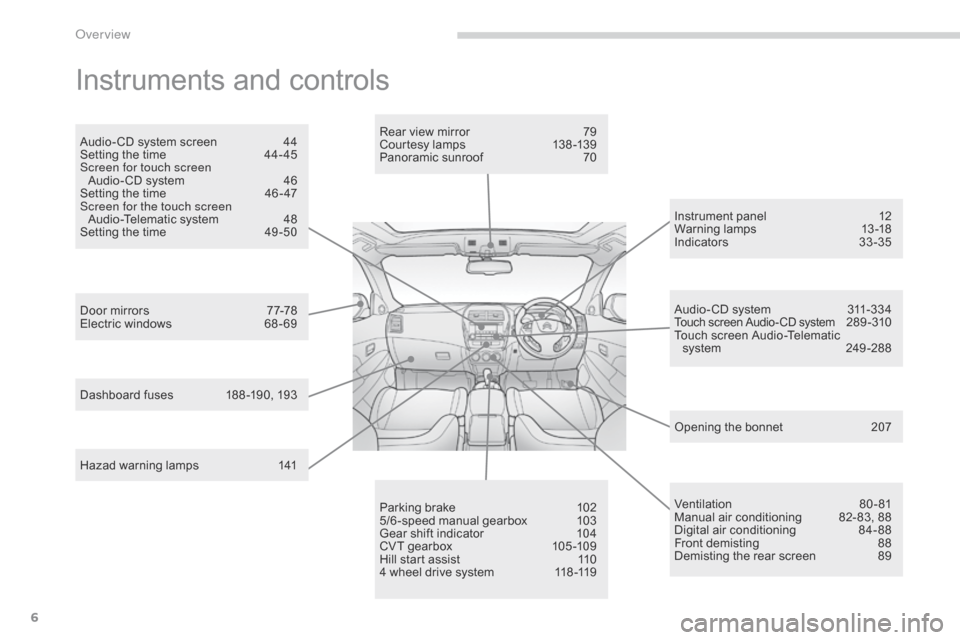
6
Instruments and controls
Opening the bonnet 207
Door mirrors
7
7-78
Electric windows
6
8 - 69 Rear view mirror
7
9
Courtesy lamps
1
38 -139
Panoramic sunroof
7
0
Dashboard fuses
1
88 -190, 193 Instrument panel
1
2
Warning lamps
1
3-18
Indicators
33
-35
Audio- CD system screen
4
4
Setting the time
4
4- 45
Screen for touch screen Audio- CD system
4
6
Setting the time
4
6 - 47
Screen for the touch screen Audio-Telematic system
4
8
Setting the time
4
9 -50
Parking brake
1
02
5/6 -speed manual gearbox
1
03
Gear shift indicator
1
04
CVT gearbox
1
05 -109
Hill start assist
1
10
4 wheel drive system
1
18 -119 Audio- CD system
3
11-334
Touch screen Audio- CD system 289 - 310
Touch screen Audio-Telematic system
2
49 -288
Ventilation
8
0-81
Manual air conditioning
8
2- 83, 88
Digital air conditioning
8
4-88
Front demisting
8
8
Demisting the rear screen
8
9
Hazad warning lamps
1
41
over view
Page 12 of 389
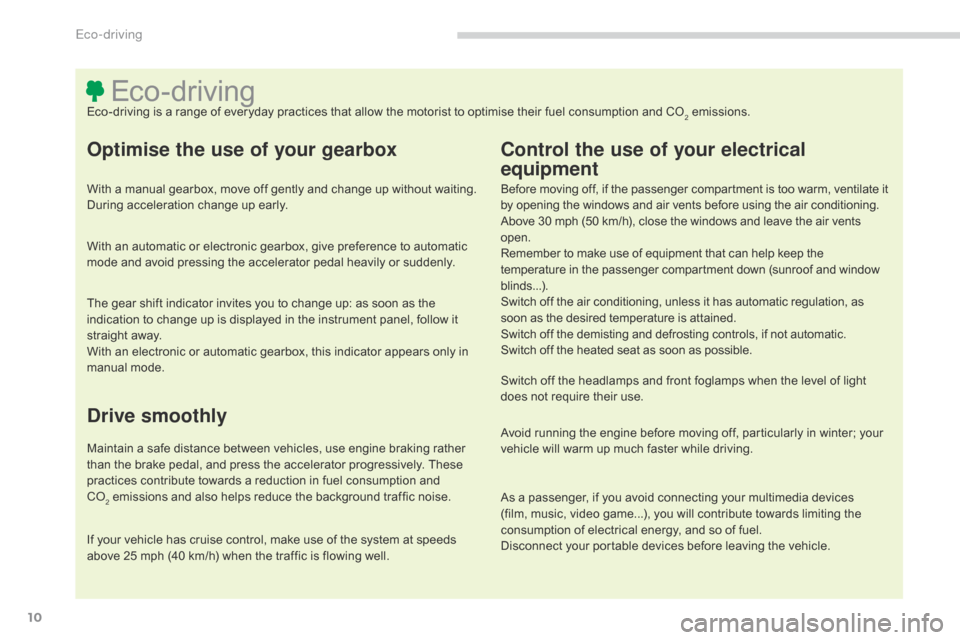
10
Eco-drivingEco-driving is a range of everyday practices that allow the motorist to optimise their fuel consumption and CO2 emissions.
Optimise the use of your gearbox
With a manual gearbox, move off gently and change up without waiting.
During acceleration change up early.
With an automatic or electronic gearbox, give preference to automatic
mode and avoid pressing the accelerator pedal heavily or suddenly.
The gear shift indicator invites you to change up: as soon as the
indication to change up is displayed in the instrument panel, follow it
straight away.
With an electronic or automatic gearbox, this indicator appears only in
manual mode.
Drive smoothly
Maintain a safe distance between vehicles, use engine braking rather
than the brake pedal, and press the accelerator progressively. These
practices contribute towards a reduction in fuel consumption and
Co
2 emissions and also helps reduce the background traffic noise.
Control the use of your electrical
equipment
Before moving off, if the passenger compartment is too warm, ventilate it
by opening the windows and air vents before using the air conditioning.
Above 30 mph (50 km/h), close the windows and leave the air vents
open.
Remember to make use of equipment that can help keep the
temperature in the passenger compartment down (sunroof and window
blinds...).
Switch off the air conditioning, unless it has automatic regulation, as
soon as the desired temperature is attained.
Switch off the demisting and defrosting controls, if not automatic.
Switch off the heated seat as soon as possible.
Switch off the headlamps and front foglamps when the level of light
does not require their use.
Avoid running the engine before moving off, particularly in winter; your
vehicle will warm up much faster while driving.
As a passenger, if you avoid connecting your multimedia devices
(film, music, video game...), you will contribute towards limiting the
consumption of electrical energy, and so of fuel.
Disconnect your portable devices before leaving the vehicle.
If your vehicle has cruise control, make use of the system at speeds
above 25 mph (40 km/h) when the traffic is flowing well.
Eco-driving
Page 53 of 389
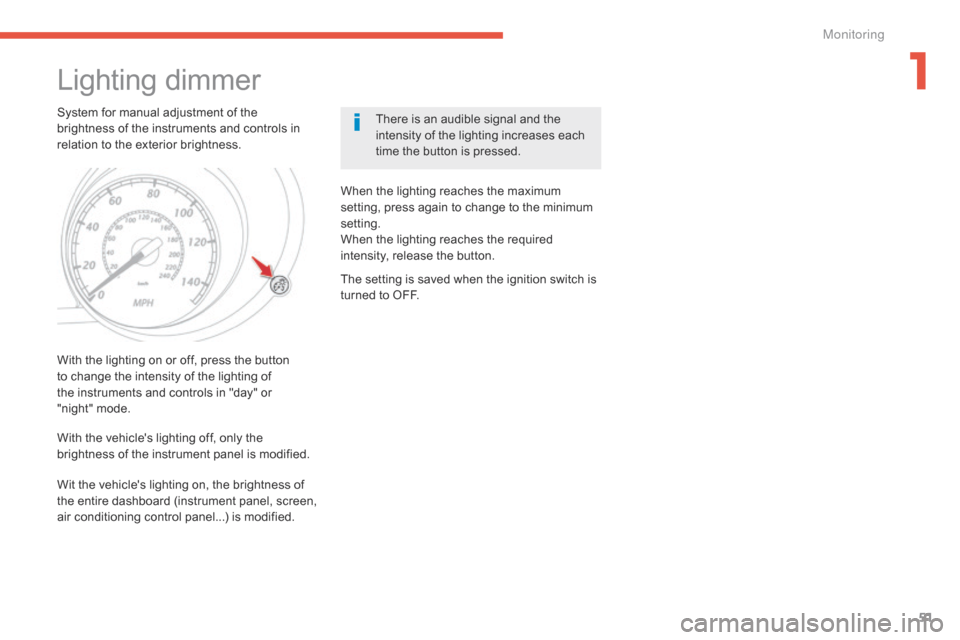
51
Lighting dimmer
System for manual adjustment of the
brightness of the instruments and controls in
relation to the exterior brightness.There is an audible signal and the
intensity of the lighting increases each
time the button is pressed.
With the lighting on or off, press the button
to change the intensity of the lighting of
the instruments and controls in "day" or
"night"
mode. When the lighting reaches the maximum
setting, press again to change to the minimum
setting.
When the lighting reaches the required
intensity, release the button.
With the vehicle's lighting off, only the
brightness of the instrument panel is modified. The setting is saved when the ignition switch is
turned to OFF.
Wit the vehicle's lighting on, the brightness of
the entire dashboard (instrument panel, screen,
air conditioning control panel...) is modified.
1
M
Page 82 of 389
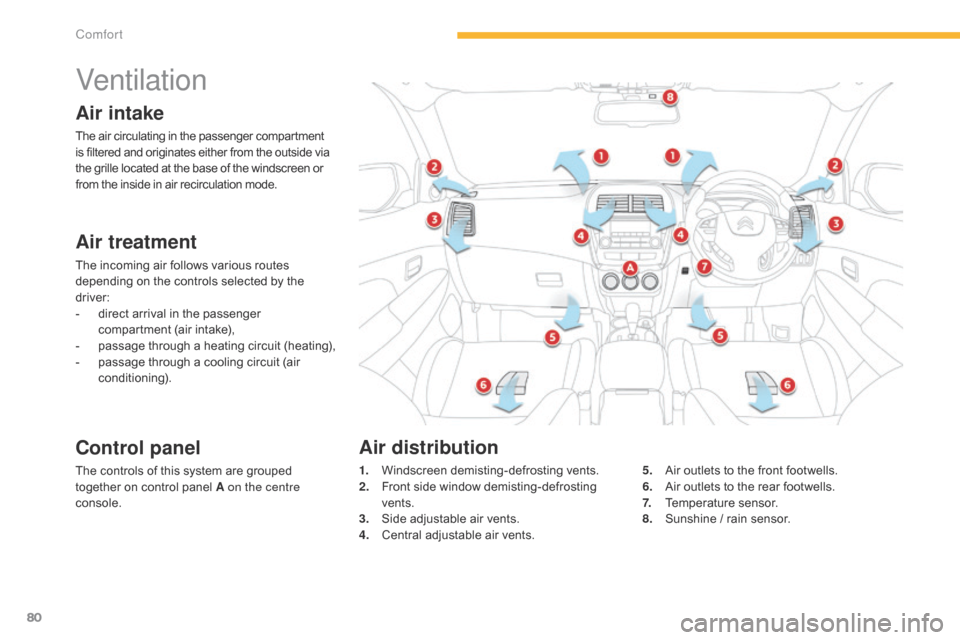
80
Ventilation
Air intake
The air circulating in the passenger compartment
is filtered and originates either from the outside via
the grille located at the base of the windscreen or
from the inside in air recirculation mode.
Air treatment
The incoming air follows various routes
depending on the controls selected by the
driver:
-
d
irect arrival in the passenger
compartment (air intake),
-
p
assage through a heating circuit (heating),
-
p
assage through a cooling circuit (air
conditioning).
Control panel
The controls of this system are grouped
together on control panel A on the centre
console. 1. W
indscreen demisting-defrosting vents.
2. F ront side window demisting-defrosting
vents.
3.
S
ide adjustable air vents.
4.
C
entral adjustable air vents.5. A
ir outlets to the front footwells.
6. A ir outlets to the rear footwells.
7.
T
emperature sensor.
8.
S
unshine / rain sensor.
Air distribution
Comfort
Page 83 of 389
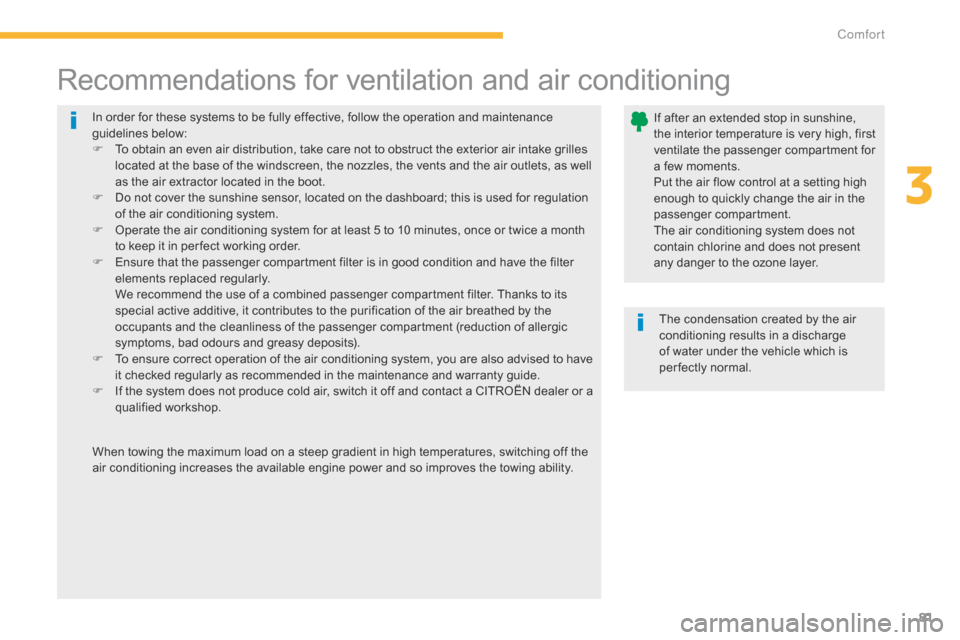
81
In order for these systems to be fully effective, follow the operation and maintenance
guidelines below:
F
T
o obtain an even air distribution, take care not to obstruct the exterior air intake grilles
located at the base of the windscreen, the nozzles, the vents and the air outlets, as well
as the air extractor located in the boot.
F
D
o not cover the sunshine sensor, located on the dashboard; this is used for regulation
of the air conditioning system.
F
O
perate the air conditioning system for at least 5 to 10 minutes, once or twice a month
to keep it in per fect working order.
F
E
nsure that the passenger compartment filter is in good condition and have the filter
elements replaced regularly.
W
e recommend the use of a combined passenger compartment filter. Thanks to its
special active additive, it contributes to the purification of the air breathed by the
occupants and the cleanliness of the passenger compartment (reduction of allergic
symptoms, bad odours and greasy deposits).
F
T
o ensure correct operation of the air conditioning system, you are also advised to have
it checked regularly as recommended in the maintenance and warranty guide.
F
I
f the system does not produce cold air, switch it off and contact a CITROËN dealer or a
qualified workshop.
Recommendations for ventilation and air conditioning
If after an extended stop in sunshine,
the interior temperature is very high, first
ventilate the passenger compartment for
a few moments.
Put the air flow control at a setting high
enough to quickly change the air in the
passenger compartment.
The air conditioning system does not
contain chlorine and does not present
any danger to the ozone layer.
The condensation created by the air
conditioning results in a discharge
of water under the vehicle which is
per fectly normal.
When towing the maximum load on a steep gradient in high temperatures, switching off the
air conditioning increases the available engine power and so improves the towing ability.
3
C
Page 84 of 389
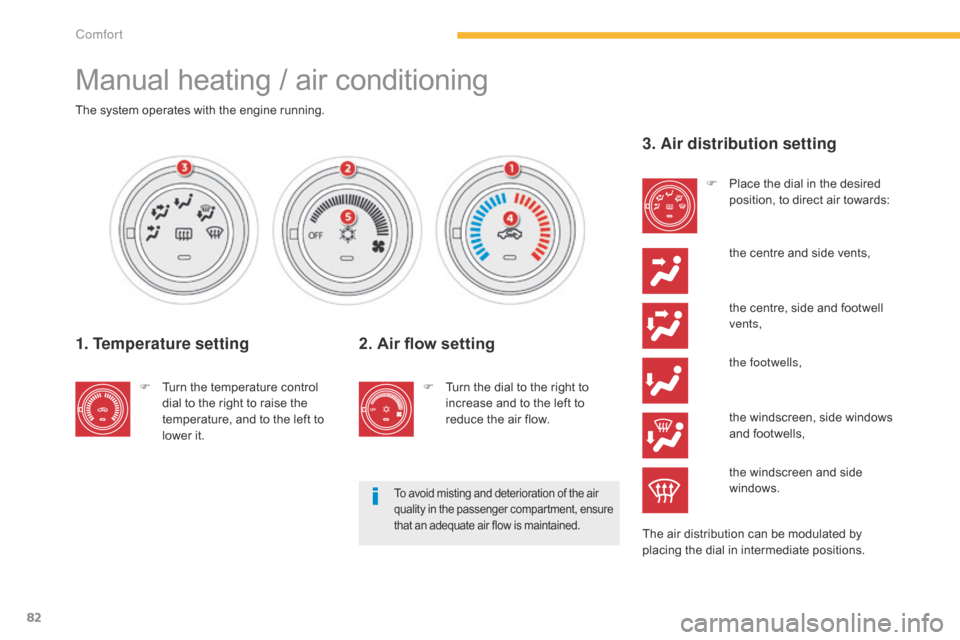
82
Manual heating / air conditioning
The system operates with the engine running.
1. Temperature setting
F Turn the temperature control dial to the right to raise the
temperature, and to the left to
lower it.
To avoid misting and deterioration of the air
quality in the passenger compartment, ensure
that an adequate air flow is maintained.
3. Air distribution setting
F Place the dial in the desired position, to direct air towards:
t
he centre and side vents,
The air distribution can be modulated by
placing the dial in intermediate positions.
2. Air flow setting
F Turn the dial to the right to increase and to the left to
reduce the air flow.
t
he centre, side and footwell
vents,
t
he footwells,
t
he windscreen, side windows
and footwells,
t
he windscreen and side
windows.
Comfort
Page 85 of 389
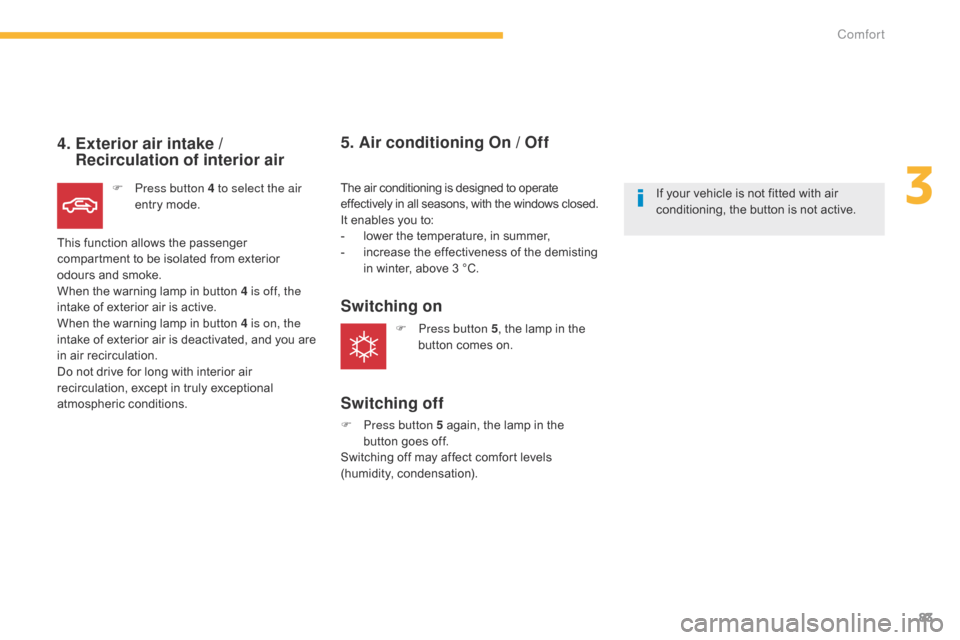
83
4. Exterior air intake / Recirculation of interior air
F Press button 4 to select the air
entry mode.
This function allows the passenger
compartment to be isolated from exterior
odours and smoke.
When the warning lamp in button
4 is off, the
intake of exterior air is active.
When the warning lamp in button
4 is on, the
intake of exterior air is deactivated, and you are
in air recirculation.
Do not drive for long with interior air
recirculation, except in truly exceptional
atmospheric conditions. The air conditioning is designed to operate
effectively in all seasons, with the windows closed.
It enables you to:
-
l
ower the temperature, in summer,
-
i
ncrease the effectiveness of the demisting
in winter, above 3 °C.
5. Air conditioning On / Off
Switching on
Switching off
F Press button 5 again, the lamp in the button goes off.
Switching off may affect comfort levels
(humidity, condensation). If your vehicle is not fitted with air
conditioning, the button is not active.
F
P
ress button 5
, the lamp in the
button comes on.
3
Comfort
Page 86 of 389
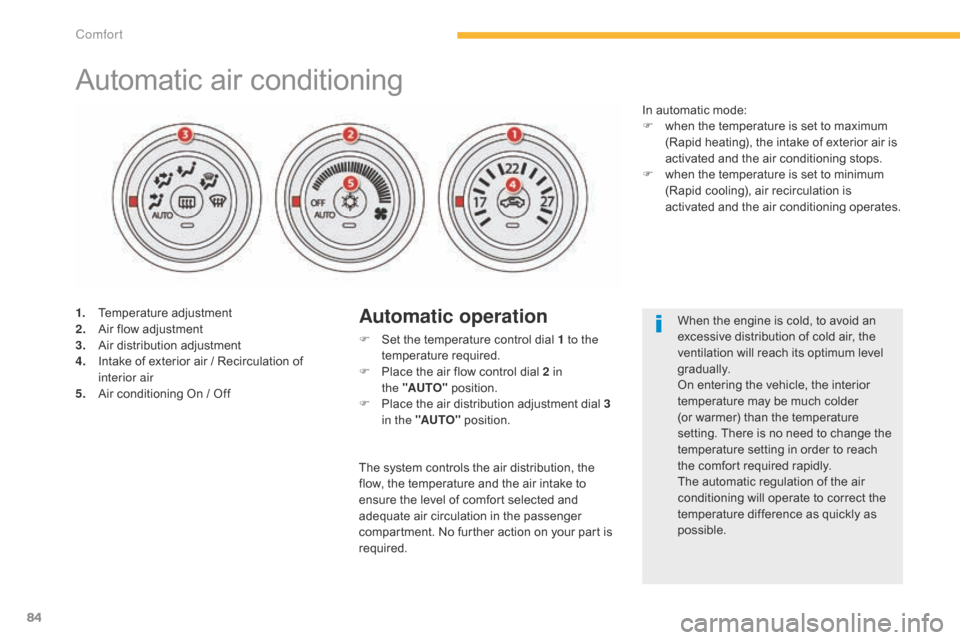
84
Automatic air conditioning
1. Temperature adjustment
2. Air flow adjustment
3.
A
ir distribution adjustment
4.
I
ntake of exterior air / Recirculation of
interior air
5.
A
ir conditioning On / OffAutomatic operation
F Set the temperature control dial 1 to the temperature required.
F
P
lace the air flow control dial 2 in
the
"AUTO" position.
F
P
lace the air distribution adjustment dial 3
in the "AUTO" position. When the engine is cold, to avoid an
excessive distribution of cold air, the
ventilation will reach its optimum level
gradually.
On entering the vehicle, the interior
temperature may be much colder
(or warmer) than the temperature
setting. There is no need to change the
temperature setting in order to reach
the comfort required rapidly.
The automatic regulation of the air
conditioning will operate to correct the
temperature difference as quickly as
possible.
In automatic mode:
F
w
hen the temperature is set to maximum
(Rapid heating), the intake of exterior air is
activated and the air conditioning stops.
F
w
hen the temperature is set to minimum
(Rapid cooling), air recirculation is
activated and the air conditioning operates.
The system controls the air distribution, the
flow, the temperature and the air intake to
ensure the level of comfort selected and
adequate air circulation in the passenger
compartment. No further action on your part is
required.
Comfort
Page 89 of 389
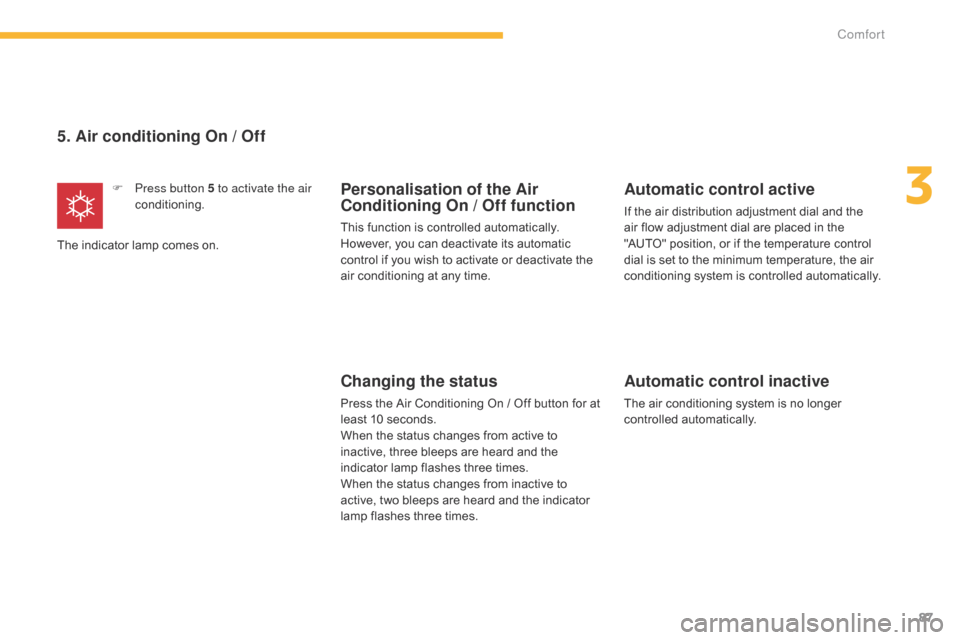
87
5. Air conditioning On / Off
F Press button 5 to activate the air
conditioning.
The indicator lamp comes on.Personalisation of the Air
Conditioning On / Off function
This function is controlled automatically.
However, you can deactivate its automatic
control if you wish to activate or deactivate the
air conditioning at any time.
Changing the status
Press the Air Conditioning On / Off button for at
least 10 seconds.
When the status changes from active to
inactive, three bleeps are heard and the
indicator lamp flashes three times.
When the status changes from inactive to
active, two bleeps are heard and the indicator
lamp flashes three times.
Automatic control active
If the air distribution adjustment dial and the
air flow adjustment dial are placed in the
"AUTO" position, or if the temperature control
dial is set to the minimum temperature, the air
conditioning system is controlled automatically.
Automatic control inactive
The air conditioning system is no longer
controlled automatically.
3
Comfort